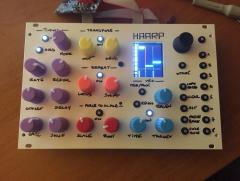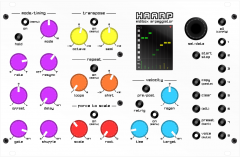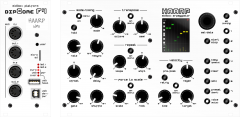-
Posts
1,291 -
Joined
-
Last visited
-
Days Won
101
Content Type
Profiles
Forums
Blogs
Gallery
Everything posted by Antichambre
-
Hi, there's no problem with that. 2 cases, device says "I'm here!" or host polls something like "are you here?"... In both cases the device always waits for a stable power to say something. No need of a complicated solution. Best regards Bruno
-
Did you invert the 2 last modules?
-
ok. And physically, did you check the cs lines with the oscillo? you should see a periodic pulse.
-
Hi Chris, Do you test it without the NG with a regular app first? Can you share the code you change in MIOS32, whole AINSER files? Best Bruno
-

The HAARP, a Hardware Advanced Arpeggiator.
Antichambre replied to Antichambre's topic in MIDIbox User Projects
Hello! A short jam video with the HAARP, the first one with the new ADS-7 from AVP Synth ;) -
Yes obviously So @totoRaymond you will need single linear track moto-fader ;)
-
really? then how do you get the position from the faders? You use 'dual taper' fader, one for the audio and the other for AIN? Best
-
It's the same, I'm not sure but there's no audio signal passing thru his faders, there's surely VCA for that purpose, the part that you don't need. But you will need faders, motor control etc... Best!
-
Bienvenue totoRaymond Sacré pseudo! ;) I hope @Zam will not blame me for quoting him here again, but he already has a project that looks like yours, except that his is already well advanced, take a look at it, Good luck anyway and have fun with your midibox stuff! Best regards Bruno
-
Did you check your local electronic shop? Personally I live in a small city, less than 20K people but there's one electronic shop with IDC connectors in stock ;)
-
Better too if you're happy with it and want to share a few. Cheaper for everybody, and just the price of some cheap components more for you. SO package on bottom side sounds good for your CS.
- 16 replies
-
- midibox fm
- mbfm
-
(and 2 more)
Tagged with:
-
@Thomasch it's clear now... Rows are matriced, Columns are not. I suppose you talk about Vs instead of Vc, and yes it's a ground, you can connect Vs bus to ground or Swithes pin directly to ground, it doesn't matter. You can maybe put all the ICs(DIN/DOUT) on this PCB, and connect your CS directly to the Core. It will be cheaper, it will take less space and limit the number of interconnections.
- 16 replies
-
- midibox fm
- mbfm
-
(and 2 more)
Tagged with:
-
Seems to be matricing... Could you explain how you connected the leds and switches, which example did you take?(There is a lot here, try BLM as keyword search). I don't understand why some of the switches are connected to 3 busses and Vc which seems to be... a ground? it can't be with a matrix connection. :/ There's maybe a misunderstanding, you don't need to connect both 'normally open' terminals, check the datasheet cause they are often internally connected and used for PCB routing ease, anyway you need only one terminal. Seems to miss some diodes for the switches too, there's no pull-up resistors but they are maybe close to the ICs and on an other diagram. @latigid on is better than me for BLM stuff it might be more clear for him ;) but @Thomasch better if you explain a few first... Best
- 16 replies
-
- midibox fm
- mbfm
-
(and 2 more)
Tagged with:
-
When you design a 'control surface' PCB, first thing to think about is the different height of the components, pots, encoders, button+caps and screen. By changing the part (e.g. EC12) and/or reference within the part(e.g. EC12E1220407) you can try to make them match This must be considered first with stand-off length, panel thickness etc... now you know. ;) But he didn't reply after I don't know if it was working for him. Best regards
- 16 replies
-
- midibox fm
- mbfm
-
(and 2 more)
Tagged with:
-

The HAARP, a Hardware Advanced Arpeggiator.
Antichambre replied to Antichambre's topic in MIDIbox User Projects
Thank you Guys! :) -
That's what I finally did too, that's what I wanted, it's clearly enough. But it should not be done with the transparent Keycap, the result is bad and ugly. Yes #18 congratulation
-

The HAARP, a Hardware Advanced Arpeggiator.
Antichambre replied to Antichambre's topic in MIDIbox User Projects
Or enter the note sequentially like any old synth do, don't worry i know how ;) I already through about this feature and consider the architecture for it too since the beginning, I want it too, but It's a step by step work. Once I publish it, anyone can enhance it, And I will be very happy about this, thankful too. You really have to go into the MIOS32 if you already use an Arduino, and have some coding knowledge,it is not so much more difficult. I don't deserve anything, this OS is made for music. You want a bpm generator, here it is, you need a button and led matrix here too, you wants potentiometers to you project, no problem etc... everything is already there and ready to use. Not for moment, I though about this too, we can define note number 0 as a silent note and treat like only for the MODE 'User Pattern" feature we mention above For overlap(Poly)This is a MIDI voice feature only, they can control CV/Gate too. But a polyphonic processing to control multiple CV/Gate is possible. I use the sequencer module and midi note are scheduled so you can set it by the length you want, they are not limited by the mechanic of the arpeggiator and the step length. Some sub parameters for each section or panel parameters will appear when the SECTION MENU pages will be available, like for RATE normal/triplet/dotted filtering for the potentiometer to jump over these timing periods, and avoid timing mistakes for real-time too and create good snapping effect for example ;) yes i forgot to show them. OFFSET is within the range of +/- the arpeggio note length, with it you shift the note in the steps, but the notes keep their order in fact you just select the note to start with. DELAY, it delay the whole arpeggio sequence in the range of a step duration. Each panel parameter will have their CC number and an associated modulation CC number, all accessible from the CV In too, it's MENU things. -

The HAARP, a Hardware Advanced Arpeggiator.
Antichambre replied to Antichambre's topic in MIDIbox User Projects
@Hawkeye I just remember that I made the "Force To Scale" as a regular module, for quick implementation and use in any app. https://www.dropbox.com/s/q8tais6dmtcnny8/force_to_scale.zip?dl=1 -

The HAARP, a Hardware Advanced Arpeggiator.
Antichambre replied to Antichambre's topic in MIDIbox User Projects
This feature can be easily considered. we can add some 'USER Patterns' in the MODE parameters. I will give it a try when I will add other Modes like converge/diverge etc... Like it is, the AINSER module works only for MCP3208, there's no define for this point, but it's possible to enhance it for MCP3204 and 3202, you must read only 4 or 2 channels instead of 8 on each muxed lines increment and manage the data position in the array. It's possible but I did not I don't use the AINSER module, I re-write an adapted one in the app directly, It let the AINSER module available for other features. Yes it's a special driver but I write it as an app_lcd module this can be reuse for other app, the MIOS32_LCD and GLCD functions continue to work if you correctly set the back and fore colors, but some direct APP_LCD_xxx functions were added for specific pixel depth. I will make this code available on next commit, It's also a good practice for me to work on a personal repo before working on the MCAN branch of the official MIOS32 repo. Best Bruno -

crimic-live-at-JET-Benefiz-Concert-2019-06-07
Antichambre replied to Phatline's topic in Songs & Sounds
Nice, I remember doing it also in front of all my college for a end-year party, my friend, a very good guitarist, improvised while I had only a drum machine. I hope for you things have changed because for us everyone looked at us with big questioning eyes and the sound manager tended to put us in the wheels. lol Best Bruno -

The HAARP, a Hardware Advanced Arpeggiator.
Antichambre replied to Antichambre's topic in MIDIbox User Projects
Hi Peter, There is really no problem. LOOPA and HAARP are more complementary than competitive. Both are "real time" oriented but have different use and operation. (I do not remember if you implemented the "Force To Scale" if it's not the case, it can be a good feature on your machine too.) Internally their process structure are very different, but if you want to know how I coded some parameters, tell me if I can 'help', even if I feel pretentious to say that to someone who codes better than me. There is no competing here, the important thing is to give life to all that and share it. But for sure, it's better if our machines or modules can be complementary. I also look forward to the @Phatline's CC-Looper, here again we are in the complementary. Best regards Bruno -
From the album: The HAARP
-
From the album: The HAARP
-

The HAARP CS in eurorack version with the Core Module.
Antichambre posted a gallery image in Members Gallery
From the album: The HAARP





